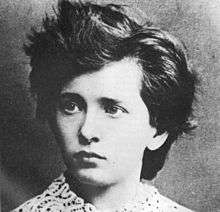Concerto for Piano and String Quartet (Busoni)
| Concerto for Piano and String Quartet | |
|---|---|
| by Ferruccio Busoni | |
 The composer in 1877 | |
| Other name | Concerto for Piano and Strings |
| Key | D minor |
| Catalogue | |
| Composed | 1878: Graz |
| Published | 1987: Wiesbaden |
| Movements | 4 |
Ferruccio Busoni composed his Concerto for Piano and String Quartet in D minor, Op. 17, BV 80, in 1878, at the age of twelve.[1][2] The original title was Concerto per piano-forte con accompagnamento di quartetto ad arco, Op. 17. Conceived for string quartet, the piano can also be accompanied by a string orchestra as Concerto for Piano and Strings, the title under which it was published in 1987.
Background
Busoni was a child prodigy, first taught mostly by his father, both as a pianist and a composer. After studies in Vienna from age nine to eleven at the Vienna Conservatory, Busoni moved to Graz for health reasons in October 1877.[3] The composer Wilhelm Kienzl remembered that he improvised at a mature level: "Sitting at the piano he was inspired to the most profound seriousness and totally absorbed in his task".[3] Kienzl initiated Busoni to study with Wilhelm Mayer. Some of Busoni's early pieces were published then, including two settings of the Ave Maria and piano pieces.[4]
The score and parts are kept by the Staatsbibliothek Preussischer Kulturbesitz in Berlin as part of Busoni's Nachlass.[5]
Composition
The structure of the work is in four movements. As such it resembles a classical string quartet more than a piano concerto, which typically has three movements:
- Allegro
- Adagio
- Scherzo – Trio
- Allegro vivace[2]
The duration is given as 20 minutes.[1] The work shows little premonition of the characteristics of Busoni's mature compositions, but rather pursues Mozart's models.[1] The reviewer of the first recording notes that the first entry of the piano shows "personalised nuance" and that the "Adagio has an unexpected seriousness but also a chaste intimacy and delicacy.[1] The lyrical Scherzo is reminiscent of Schubert, and the rather "conventional" finale is a display of compositional skill, including fine interplay between the piano and the strings.[1]
Publication and recording
The concerto was published by Breitkopf & Härtel, Wiesbaden, in 1987, edited by Larry Sitsky. The editor recommends, based on markings of tutti and divisi, to use a string orchestra, with double bass reinforcing the cellos, which was a common practise at composition time.[6]
It was first recorded in 1999 by Carlo Grante and the ensemble I Pomeriggi Musicali, conducted by Marco Zuccarini.[2][7]
References
- 1 2 3 4 5 Woolf, Jonathan (2003). "Ferruccio BUSONI (1866–1924) / Works for Piano and Orchestra". musicweb-international.com. Retrieved 28 February 2016.
- 1 2 3 "Ferruccio Busoni / Concerto, for piano & string quartet in D minor, Op. 17, KiV 80". AllMusic. Retrieved 25 February 2016.
- 1 2 Couling, Della (2005). Ferruccio Busoni: "a Musical Ishmael". Scarecrow Press. pp. 27–44. ISBN 9780810851429.
- ↑ Wirth, Helmut (1980). "Busoni, Ferruccio (Dante Michelangelo Benvenuto)". The New Grove Dictionary of Music and Musicians. 3. London: Macmillan. pp. 508–509. ISBN 0-333-23111-2.
- ↑ "Concerto für Klavier und Streichorchester d-Moll Kindermann-Verzeichnis 80 = Concerto for piano and string orchestra D minor". searchworks.stanford.edu. Retrieved 25 February 2016.
- ↑ "Concerto für Klavier und Streichquartett, d-Moll Kindermann-Verzeichnis 80 / Concerto for piano and string orchestra, d minor". searchworks.stanford.edu. Retrieved 25 February 2016.
- ↑ "Concerto in D-, for piano and string quartet, Op.17, KiV 80". arkivmusic.com. Retrieved 25 February 2016.